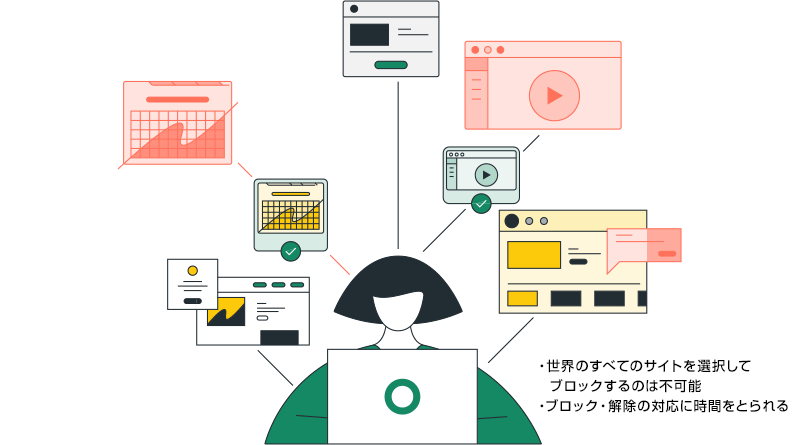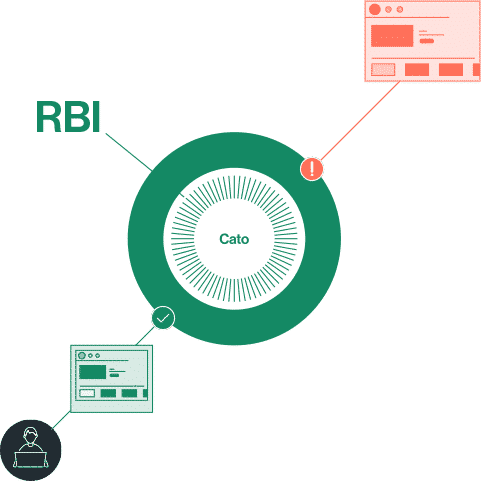product
- About Cato Networks
- About Cato SASE Cloud
- Unification of shadow IT countermeasures by Cato CASB,
- Information leakage countermeasures with Cato Smart DLP
- Safe website browsing with Cato RBI
- CATO socket Easily connect existing LAN environment to SASE. Migration to SASE made easy
- Cato SASE XDR
- Cato DEM(Digital Experience Monitoring)
service
Application for evaluation machine
- FAQ

Cato Networks
Cato Networks
Cato RBI (Remote Browser Isolation, Web isolation function)
Easily implement security measures for web browsing required for digital transformation
In the era of digital transformation, web browsing has become an important tool for employees. However, the internet is full of threats such as phishing, malware, ransomware, and zero-day attacks. Browsers run website code on your local device, making browsing a serious security risk. Malicious code can allow cybercriminals to infiltrate your device and from there into your network.
Organizations can't completely prevent users from clicking malicious links, so they typically use Secure Web Gateways (SWGs) or proxies to block malicious sites.
SWG and Proxy can allow good sites and block bad sites, but what about new sites? IT administrators can prioritize security by instructing SWGs and proxies to block new uncategorized sites. However, with so many websites being created every day, users may find themselves unable to access the web, reducing productivity and increasing frustration.
RBI protects against malicious sites by isolating malicious content (such as javascript and CSS) from users' devices and processing that content within the SASE cloud. Send a secure page to your device.
For uncategorized websites, Cato RBI provides administrators with a new "isolation" configuration option to ensure secure browsing by end users. This gives you the best of both worlds: security and productivity.
RBI protects users while using the web without sacrificing productivity. This adds an additional layer of protection against web and browser-based threats, protecting you from new attacks not yet documented, new unclassified sites, and errors.

Cato RBI adds another way to protect against web-based threats.
Cato's Remote Browser Isolation (RBI) service provides secure browsing through a virtualization service that securely streams web pages to your device. Code within the browser is executed remotely to protect users from threats such as ransomware and phishing.
Cato RBI is easy to use and allows administrators to select different options for uncategorized sites. In addition to "Allow," "Block," and "Prompt," add an RBI "Isolation" option in the admin screen.
Cato RBI is also easy to set up. Unlike competitors that require complex setup, you can access it in minutes with just a few clicks. Cato RBI requires no maintenance. There's nothing to install or patches to apply.
When enabled, it applies to all internet traffic from all edges. No need to set it up separately for multiple locations or different edges.
Cato RBI is flexible. Some vendors require all traffic to go through RBI, but Cato's robust multi-layered protection (IPS, Anti-Malware, Next Generation Anti-Malware, CASB, DLP, etc.) allows administrators to route all traffic through RBI. You can choose which traffic you want.
Cato RBI protects users from hundreds of potential browser-related attacks against unclassified sites and does the right thing without relying on the user. With Cato RBI, you can improve your security posture in minutes without impacting user productivity.
You can allow good sites, block bad sites, and use RBI for sites that are difficult to judge. This dramatically improves security operations for administrators.

Only sanitized site information is delivered to the user's browser, and malicious programs will not run.
Differences between Cato RBI and other companies' RBI
| Existing RBI | Cato RBI | |
| Build/Introduce | slow and complicated Some RBI solutions require complex and time-consuming configuration. Some solutions require deploying virtual machines and setting up IP addresses, DNS, and certificates. It also requires an interface with a security platform. |
fast and simple Cato RBI can be accessed in minutes with just a few clicks. No configuration required, ready to use. Administrators simply set a new option to "separate" uncategorized pages, along with "allow," "block," and "prompt." |
| Operation management | composite Some RBIs require ongoing maintenance, patching, and upgrades. Third-party integrated RBIs may require separate contracts, billing, administration, and support. |
everything simple Cato RBI is zero maintenance. There's nothing to install or patch. Because it's a seamless part of the Cato SASE service. |
| Security | Insufficient security measures Some RBIs use Document Object Model (DOM) mirroring. Although only dangerous page elements are removed, the browser is still sent dangerous code and may miss well-hidden malicious code. |
safer Cato's RBI securely renders web pages as a stream of pixels to the user's device. Code in the browser is executed remotely and downloads are blocked, keeping you safe. |
| Compatible range | limited Some RBIs must be configured separately for different locations or edges. |
all edges Cato RBI is applied to all web traffic from all edges. No need to set it up in multiple locations or on different edges. |
| Extended range | no flexibility RBI vendors that do not offer other protections must send all traffic through RBI. |
flexibility Cato's robust multi-layered protection (IPS, Anti-Malware, Next Generation Anti-Malware, CASB, DLP, etc.) allows administrators to choose which traffic is routed through RBI, keeping users productive and secure. Masu. |
Inquiry/Document request
Macnica Cato Networks
- TEL:045-476-2010
- E-mail:cato-sales@macnica.co.jp
Weekdays: 9:00-17:00


